#gay sex virus
Text
1001+ New British And Irish Themed Jokes
New Adult Jokes Daily – Guaranteed To Make You Laugh Or Your Tonsils Back!
Welcome! Céad Míle Fáilte 欢 google-site-verification: google4de88e90fa1080a9.html
Original jokes – created and crafted by Francis R Sturt
JOKES OF THE DAY: 21/01/2024What did the police officer say to three monks having sex? Halo! Halo! Halo! What is Scouting For Girls? Boy Scouts without the sex. Two agents are in the…

View On WordPress
#501 new jokes#601 new original jokes#bespoke#british and irish#british jokes#catholics and protestants#children and kids#comedy and crazy.#corona virus#covid 19#drink and beer#gays and lesbians#hilarious adult sex#hilarious and very funny#intelligent and clever#irish jokes#irish sea border#laughter#original jokes#pubs and bars#religion and church#sex and love#third world war#United Ireland#world war 3#zany and mad
0 notes
Text
Imagine one day a new social trend starts spreading. It’s something unbelievably dumb. Not harmful per de, but truly silly to believe. Let’s say, I dunno, healing crystals start going mainstream. Everybody’s talking about their crystals. It becomes impolite to criticize people who believe in healing crystals. They become a big part of people’s personalities, and people on TV start talking about them, and one day years down the line politicians are debating funding for crystal-based medicine. And through it all you are sitting there going, what the fuck is happening. I thought we were all on the same page on this. You want to get along and be friendly and open minded but you cannot pretend to believe in healing crystals, this is nonsense, and when the topic comes up you refuse to lie about it. This eventually starts to have social consequences—they’re that popular!—but what can you do? You cannot pretend a lump of quartz can cure the flu or whatever. It’s just all so unbearably embarrassing.
I think what the centrist/liberal/center-left reactionary turn driven by culture war stuff feels like. And I think the key emotion is probably cringe. Not hate, not fear, though those emotions may reinforce the turn. I think in a lot of cases people who imagine themselves pretty open minded and flexible have as part of their worldview something they thought was bedrock social consensus—on the level of “healing crystals are silly woo”—so bedrock maybe that it didn’t even need to be a conceptual boundary they actually policed in their minds.
For instance, when she started her anti-trans turn, JK Rowling made a big show of not being really anti trans, just arguing that Some People Had Gone Too Far. She wasn’t a frothing religious reactionary, after all. And I believe that’s probably true! I think Rowling probably did have a mental model of sex and gender with a little bit of give in it—of the “we can humor the odd weirdo” type. But as the discussion of trans rights in the UK got more serious over her lifetime, trans people went from “the odd weirdo” to “a recognized minority,” and eventually this ran against a bedrock belief that on some level men are men and women are women and never the twain shall meet. To act otherwise was just too embarrassing. And she wasn’t going to embarrass herself in the name of political correctness.
Other people whose brains have been eaten by the anti-woke mind virus (as @eightyonekilograms calls it) have something going of the contrarian in them, who enjoys yelling “up yours, woke moralists!” or w/e. Im thinking of ppl like Glenn Greenwald here, or Dave Chapelle, people who seem not to feel alive except when people are mad at them. That’s a separate but interesting dynamic. And there are people like Graham Linehan who become totally unhinged through this process of auto-radicalization, moths drawn ever closer to a particular source of validation within their chosen reactionary subcommunity, until they are truly parodies of themselves. That is also an important dynamic, but it’s one that only takes hold after the initial turn has begun.
I think the role of that feeling of cringe, that refusal to entertain an idea because it is too embarrassing (even if it does actually have a decent body of research behind it, unlike crystals) is important to think about, because I am interested in how to get people over it. I know that feeling has affected my own thinking over my lifetime. I wasn’t raised particularly conservative, but I had to learn not to cringe at a lot of feminist thought before I could appreciate it and learn from it. I explicitly didn’t have that cringe when it came to gay people for whatever reason, so it never entered my mind that it might be a problem. I remember being surprised to learn when I was very young that some boys wanted to marry other boys, but my response was “huh. Go figure.” Because for whatever reason I had not picked up that this was something I was supposed to be grossed out by. A general doctrine of empathy, of trying to understand people on their own terms, can help forestall some of this stuff, but it’s not foolproof in either direction—I don’t want to believe crystals have healing powers if it becomes socially popular to do so, just because it is socially popular to do so! And if they do, I don’t want to not believe they do just because it is socially unpopular!
(Obviously the crystals thing is not a one to one metaphor for the trans thing, so don’t read too much into that. Maybe astrology would have been a better analogy. Also I’m not talking just about people whose reactionary turn is predicated on trans issues—I think this dynamic applies to everything from gay rights to the Tridentine Mass. But trans issues are a handy example bc, as the adage goes, somebody posts once about trans people and they never post anything normal again. I think the classic rapid-onset trans derangement syndrome is closely tied to the fact that gender norms are a really deep element of many people’s social-consensus-based worldview, and so challenged to that worldview are felt as really cringe.)
I’m curious if other people who grew more liberal in their thinking over time had a similar experience of having to overcome what was basically a feeling of embarrassment at certain ideas.
373 notes
·
View notes
Text
From the article:
A new study has confirmed what most sexually active gay men will already know: Less of us are using condoms when we have sex compared to ten years ago.
The study, published in AIDS and Behavior, was conducted by researchers at the University of Washington. It drew its data from the American Men’s Internet Survey (2014-2019). It looked specifically at men who have condomless anal sex with men who are not on PrEP.
The number of men in the study having condomless sex rose by 2.2% each year. However, the rise was greater in younger men (rising 7.2% per year for those aged 15-24 years) and Hispanic men (rising 18%).
Overall, condom use remained more popular than PrEP. This might be partly due to barriers to obtaining PrEP, among other factors. Around 15% of the men were taking PrEP.
The vast majority of men questioned believed condoms to be “very effective” (60%) or “somewhat effective” (36%) at preventing HIV transmission.
However, 24% said they “never” used condoms, compared to 50% who said they “always” or “sometimes” used them. The remainder said they rarely used them.
Clearly, there is a large number of guys having condomless sex who are not on PrEP. If their partner is HIV positive and undetectable, they cannot pass on the virus. However, not everyone knows their HIV status or is on treatment.
Besides HIV, condoms can also help prevent the transmission of other STIs. The rise in gonorrhea and syphilis diagnoses in the US in recent years is in part related to declining condom use.
#this focuses on cis men but EVERYONE needs to make sure they practice safe sex#get tested and know your status#use STI prevention methods wherever you can#news#queer news#health news
124 notes
·
View notes
Text
GUYS, IF YOU SEE A LINK ONLINE THAT SAYS "WATCH GONCHAROV (1973) FULL MOVIE FREE 3 HOUR DIRECTORS VERSION INCLUDING DELETED GAY SEX SCENES", DONT CLICK IT.
ITS A VIRUS THAT TURNS ON CAPS LOCK ON YOUR DEVICE. AND IVE HEARD RUMORS THAT THERES NOT EVEN THAT MUCH GAY SEX INCLUDED ANYWAY SO
1K notes
·
View notes
Text
The Big AIDS Metaphor Post
In her essay "Why Are Americans Afraid of Dragons?" from her book The Language of the Night: Essays of Fantasy and Science Fiction, science-fiction and fantasy writer Ursula K. Le Guin writes—
"The use of imaginative fiction is to deepen your understanding of your world, of your fellow men, and your own feelings, and your destiny."
It would be easy for me to claim that Stranger Things is a show that utilizes its science-fiction elements as an AIDS metaphor, but that only goes so far without being able to prove that the show is in fact employing said metaphor. "The show takes place in the 80's -> AIDS was a big part of the 80's -> therefore the show is about AIDS" isn't an airtight argument in itself. I can quote famous sci-fi writers all day but that still wouldn't prove that the Duffers themselves are actually following similar trains of thought.
So here's my big long post about why the show is utilizing it's science-fiction elements as an AIDS metaphor.
Lengthy discussion of rape, violent homophobia and drug use below the cut.
A Brief History of HIV/AIDS in America
For those not in the know about HIV/AIDS, and in order to all get on the same page, here is a short recap. For my information, I will be this timeline from hiv.gov as well as this timeline created by History Channel, as well as some of the supplemental hyperlinks provided. Any other sources I use will be linked throughout.
HIV, or human immunodeficiency virus is a virus that attacks the body's immune system, making it highly susceptible to infection and cancers. The virus can progress to a more severe version of the infection, acquired immunodeficiency syndrome or AIDS. The virus spreads through bodily fluids such as semen and blood. The most common ways for HIV/AIDS to spread was through unprotected sex and sharing needles while using drugs.
The initial cases of HIV were present in America in the 70's but become much more rampant starting in the early 1980s. Because cases of AIDS were most commonly seen in gay and bisexual men, there was a large misconception that AIDS was a "gay plague" or a "gay disease" as it was nicknamed. By 1984, 3,500 Americans had died from AIDS related illnesses.
The reason that AIDS epidemic got as deadly as it did is often attributed to the Reagan Administration's failure to act, something that President Reagan denied. Reagan would not publicly acknowledge AIDS until 1985, despite U.S. health officials being aware of AIDS since 1981.
Understanding just how entrenched this metaphor is in the story will include going through each season and examining in detail how each one plays into this metaphor.
Season One: Establishing Metaphor & Government Cover Up in Early Years of Epidemic
The AIDS metaphor is most closely connected with Will's storyline, although it's not exclusive to Will nor is his storyline exclusive to AIDS. Furthermore, the supernatural elements of this show are multifaceted. AIDS is but just one of the metaphors expressed in the show, but for the sake of this post it's what I will be focusing on.
The setup begins following Will's disappearance in episode 1, when Joyce introduces Will's queer coding to us.

By 1983 the terms "gay disease" and "gay cancer" had been in the public vocabulary for a couple years now. So when Joyce brings up his queerness in regards to to his disappearance in a show that takes place in the early 1980s, there is a subconscious correlation that can be made in the watchers mind. His sexuality is significant to the why he went missing, otherwise why bring it up?
We then hear through Troy exactly what the town believes happened to Will.

I think that Troy essentially being a mouthpiece for his father is significant to show that Troy's beliefs are not exclusive to him and they do not exist in a vacuum. Troy's homophobia is a product of his environment, which includes his home and by extension, Hawkins.
The specification that Will was killed by "some other queer" adds another layer under the surface of Troy's statement, one that implies that Will was raped before he was kill, otherwise, again, why bring up sexuality in the first place? This was the attitude toward gay men— they rape and kill little boys.
In early 1984, there was a study conducted by the American Journal of Medicine to trace the sexual partners of a cluster of patients with Kaposi Sarcoma, one of the common cancers that killed AIDS patients. The study identified a flight attendant as "Patient O" who was among the first to exhibit symptoms of HIV/AIDS and had a rather active sex life with a multitude of sexual partners. The study was soon misconstrued by the public to claim that there was a Patient Zero who was "a promiscuous or even malicious gay man who single-handedly and knowingly touched off the AIDS pandemic in the United States."
Another crucial factor of the metaphor is the cover-up and blame shifting from the government lab, the exact thing that allowed the problem to escalate and become as deadly as it did to begin with. In the early years of the epidemic, Reagan slashed the budget of public health agencies like the CDC, and it would be years until he ever made a speech about it let alone even mentioned AIDS publicly.
We see how adamant the lab is to cover up any supernatural involvement with Will's disappearance in an attempt to cover their own asses. Framing his death as an accident was their call, all while being acutely aware of what the actual problem was. This confrontation from Joyce to Brenner puts it pretty aptly.
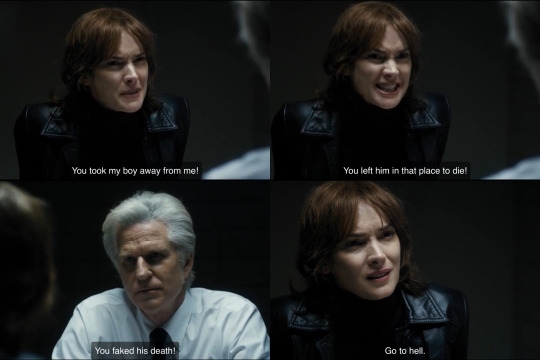
Tangent About Barb
This AIDS metaphor is something that I thought of when I first watched the show back in 2016 (humble brag) but what tipped me off the most wasn't Will or the lab but it was the fact that Barb was the other victim shown.
Barb's queer coding was clear to everyone and their mother. Hell, there's even a joke about it in the Bad Lip Reading of the first season. Barb, Nancy's short haired female friend who takes issue with Nancy's new relationship and has a hard time fitting in with with all of the heterosexual antics of Steve's house party. She's singled out, and while the rest of the gang get to casually enjoy the pleasures of sex, while Barb, another member of the queer community, sadly loses her life. The show cuts between Nancy having sex with Steve with Barb being killed to emphasize this stark contrast.

Season Two: Personal Effects of HIV/AIDS & Social Stigmatization
Season one was surrounding Will while not really showing us much of his pov, but season two dives right in to his perspective.
So, remember when I talked earlier about how Troy, and by extension the town, believed that Will was raped? Well, he wasn't exactly wrong.

This moment wasn't lost on me when I originally watched the show, although I think I ignored the implications because I didn't want to believe what I was seeing. But it's pretty well spelled out— A long, tentacle-like organ used for the sake of reproduction (Will "births" D'Art as a result of this), is inserted inside of Will's mouth without consent.
It's been a year, and Will is still dealing with the trauma of what happened, along with all of these new changes to his life. Will frequently attends doctors appointments at the lab, where the lab themselves aren't completely confident what is happening with him either.
When cases of HIV/AIDS were first appearing in the U.S., health officials were unclear as to what exactly this virus was and how it worked, only that clusters of otherwise healthy gay men were suddenly developing rare and aggressive infections and cancers.
Owens refers to the spread of the Upside Down very clinically— describing it as some cancer. One of the first articles published about HIV/AIDS in America before more information was known was a New York Times article titled "Rare Cancer Seen in 41 Homosexuals." The cancer the headline refers to being Karposi Sarcoma, the rare skin cancer developing due to their weakened immune system.

HIV/AIDS in itself isn’t the disease that patients die from, but instead the weakened immune system allows for diseases to take over the body without much defense. After his visit to the Upside Down, Will faces a series of “True Sight” visions as Mike puts it, which allows for a destructive foreign entity to invade Will's body and slowly take it over.
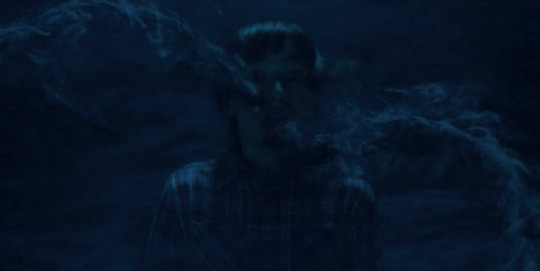
HIV.gov lists the following as some of the symptoms of AIDS:
"Rapid weight loss"
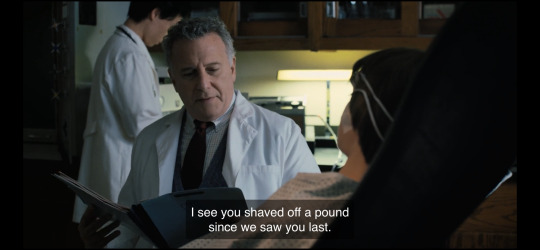
"Profuse night sweats"

and "Memory loss"

To the government agents in the lab, we see just how disposable Will is to them. In their words, if it kills him, it kills him. (thank you to @emblazons for being the one to point this out to me)
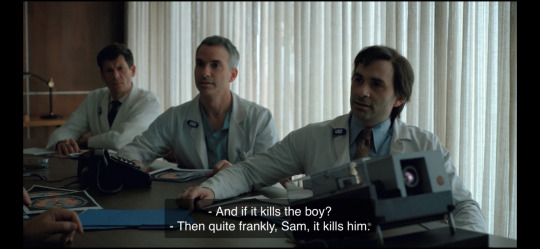
Owens may have held more concern for Will, but he still continues the government cover-up started by Brenner in season one. We also see the fallout of Barb's death, with Nancy and Jonathan fighting to uncover and reveal the truth. Owens is the one who tries to put a stop to their exposé of events to Barb's mom.

Not only is Will facing trauma and his body being ravaged by this new illness, but he's also facing social stigmatization, something common among gay men with positive HIV statuses at this time. There seemed to be some sympathy from the townsfolk when Will was missing and presumed dead, yet he faces animosity almost seemingly because he came back.
The "Zombie Boy" Nickname
I once made a whole separate post about this, but Will's "Zombie Boy" nickname from season two fits in with this AIDS metaphor.
On a surface level, the nickname is in reference to the fact that Will seemed to come back to life despite having a funeral and being buried. In a literal sense, however, his peers are quite literally referring to him a walking corpse that spreads disease. Individuals suffering from AIDS often have very short life expectancies, and zombies are the re-animated dead that aim to infect and kill as many people as possible. It is a very coded nickname.
In the post that I linked, I speculate the possibility that some people in town may even believe that Will has HIV. Remember earlier when I mentioned Troy's comment "he was probably killed by some other queer" which implies a belief that Will was raped. The town don't know about any of the supernatural goings-on, but they do know that Will went missing, was found in a cabin a week later, was hospitalized shortly after and attended frequent doctor visits through the following year. I don't see a reason that malicious rumors would cease, especially considering that they already continue to be cruel and ostracizing with the Zombie Boy nickname.
Look also at this moment of Will getting weird looks as he is being pulled from school to attend his doctors appointment. Why so much stigma around simply going to the doctor?

The 1984 Reelection of Ronald Reagan
In 1984, Ronald Reagan won reelection in one of the biggest election wins in history. And— subsequently continuing his and the governments silence towards the AIDS epidemic.

Season two takes place in the week leading up to the reelection. There are small set pieces that draw attention to this, such as this election sign in front of the library.
If the date November 6th sounds familiar, it should.
Dr. Owens mentions the anniversary of Will's disappearance. The one year anniversary of Will's disappearance is the same day that Ronald Reagan was reelected. Will's trauma is being purposefully associated with that day.

I've also made a separate post before just about the Reagan/Bush '84 signs that litter the lawns of Hawkins houses. They appear most notably in the Halloween episode, building to when Will has his true sight episode that night. There is one clearly in frame just before Will is separated from the group, called a "Zombie Boy" and a "freak" (two very coded nicknames) before he falls into his vision.

We also get a clear view of the Reagan/Bush sign outside of the Wheeler house before Will describes his experience to Mike.

A Tangent About the Wheelers
And now the question on everyone's mind: Are the Wheeler's homophobic?
Ted and Karen Wheeler are not violent, homophobic bullies. That would be a massive reach. But it would also be a reach to say that they are vocal allies. And maybe that's just what the average middle class family
In the very least, the Wheelers are passively contributing to a system that enables homophobia. To be honest, they are probably just going along with what everyone else is doing. Like I said earlier, Reagan was an incredibly popular candidate for the 1984 reelection. The Wheelers have the privilege of being able to comfortably conform without having to worry about much of the consequences. (I'll talk more about the Wheelers later)
In the episode where Will is possessed by the Mind Flayer, Joyce calls the school and we get an extended shot with Reagan's portrait in the background. The shot begins with the portrait slightly obscured, then the camera dolly's in towards the receptionist with the portrait still in frame. Shortly after this Will is possessed in the field. Here is one of the camera begins the shot and where the camera ends the shot.

I also wanna note that when Joyce calls in this scene, the receptionist makes a side comment about her and rolls her eyes. There's a clear animosity towards not only Will, but the whole Byers family, including the adults of the town. Including Reagan's portrait in this shot is meant to create a subtle correlation between him and the stigma that the Byers' face.

Season Three: The Façade of Patriotism Over a Dying Nation
It's 1985, Ronald Reagan has been reelected, and this season introduces Hawkins Mayor Larry Kline.

Is Larry Kline meant to be Ronald Reagan?
I would say that Mayor Kline is probably exemplary of American politicians in a broader sense (in fact the Duffers may have been making allusions to Trump with his connection to the Russians) although the fact that he's in office the same time as Reagan is still significant.
In the beginning of the season, Mayor Kline is being met with protesters outside his house, not unlike many of the AIDS awareness protests from the 80's.
The townsfolk are angered with Kline for building the mall and running some of the small businesses into the ground. During Reagan's run, he implemented a system of economics called "Reaganomics," which aimed to cut taxes and support economic growth. Although critics of Reaganomics will point out that his policies had actually increased the wealth gap, making the rich richer and the poor, poor. I want to keep this post about the AIDS metaphor, although I wanted to point this out as it is a connection between Kline and Reagan. And as I said earlier in this post, the metaphors are multifaceted and not just about AIDS.
But continuing, later in the season Kline puts on a big 4th of July festival to celebrate the independence of his country with neon lights and flashy fireworks. Meanwhile, the people of his town are dying right under his political reign.
During season 3, the AIDS metaphor actually moves away from Will, with the focus of his story shifting slowly to romance. This was setup at the Snowball at the end of season 2, and season 3 hints at some of Will's feelings for Mike which will be carried into season 4.
But the metaphor is carried on by Will's name twin, Billy.

Billy and Will sharing the same first name, that being William, feels significant as Will basically passes the baton to him and Billy now becomes the focus for this metaphor. We learn from Max that Billy is very sexually active, and in the beginning of the season he has eyes for Karen Wheeler. It is while he is on his way to this illicit sexual affair when he is "infected" by the Mind Flayer. (this was pointed out to me in the comment of one of my posts, but have since lost it. If you are reading this— thank you.)
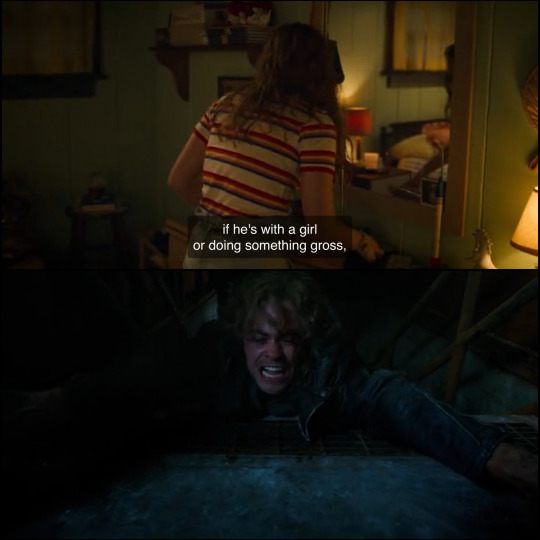
Billy then passes the "infection" along to a girl he was flirtatious with, before the "virus" begins spreading over town.

There is also language and rape imagery associated with being flayed. There is the repeated lines "hold still" and "it'll all be over soon." When Heather's parents are flayed, they are tied up something is forcefully inserted orally, not unlike what we saw with the tentacle inside of Will in season one and his possession in season two. (I first saw this pointed out by @kaypeace21

The flayed begin to eat chemicals, and Nancy makes the comment that Tom, one of the flayed, appears to have been on drugs. Another common way that HIV is spread is through the sharing of drug needles.
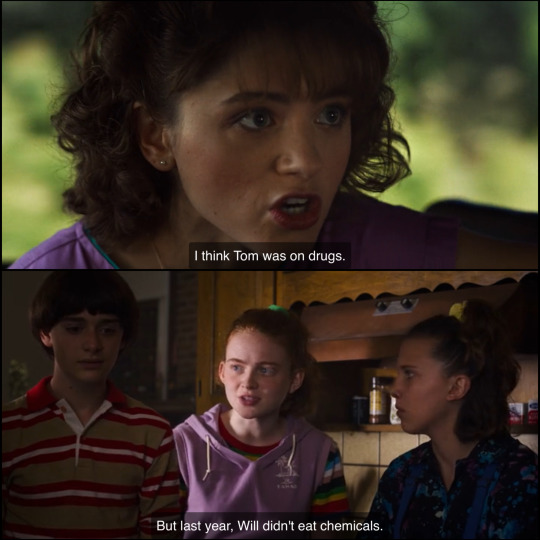
HIV/AIDS in the Press
Nancy's arc with the newspaper this season reminds me a lot of how AIDS was first being reported in the press. Nancy begins her search for a story with stolen fertilizer and diseased rats, not realizing that there was a much bigger and much more dangerous story at hand. One of the first reports HIV in the media was from a CDC Morbidity and Mortality Weekly Report from 1981, which cited five cases of pneumonia in previously healthy gay men in Los Angeles. While still a deadly number, it was relatively small compared to the massive number of AIDS cases and deaths that would soon follow.
When Nancy brings her story to work, Bruce, one of her higher-ups, sips from this rather patriotic coffee mug before telling Nancy to drop the story.

At the end of the 1985 summer in Hawkins, the flayed have died in a "mall fire" and Larry Kline is arrested for colluding with the Russians, and their patriotic façade is shattered.
In September 1985, shortly after actor and close friend of Ronald Reagan, Rock Hudson dies, of an AIDS related illness, Reagan makes his first public acknowledgement of AIDS.
Season Four: Further Stigmatization & LGBT Witch Hunting
In season four the town is finally privy to the fact that there is something wrong going on, although they are unsure of exactly what. When things begin to escalate, instead of blaming the actual guilty party, they go on an all-out witch hunt.
Once again, Will's pretty removed from the AIDS storyline in this season with his arc focusing on his romantic feelings for Mike. With Billy dead and Will out of town, the baton passes once again for the metaphor to be carried by Eddie Munson.
In the first episode of season 4, Eddie is reading a magazine with an article about the Satanic Panic, a real case of wide-spread hysteria in the 1980's regarding the fear of rising Satanism, supposedly promoted by D&D. The article links the game to violent behavior, Satanic worship, sodomy and murder.

Tangent on Sodomy and Sodomy Laws
Merriam-Webster defines sodomy as "anal or oral copulation with another person." The definition is often expanded to include copulation with animals, although the term sodomy, according to Merriam-Webster, means "especially: anal or oral copulation with a member of the same sex."
While definitions may vary depending on states, some states have specific laws outlawing sodomy, even between consenting adults. In 1986, the Supreme Court upheld Georgia's anti-sodomy laws in Bowers v. Hardwick, after a homosexual man and his partner were arrested after being caught while having sex in his own home. Sodomy laws would eventually be challenged again in 2002 with the Lawrence v. Texas case.
While sodomy can technically can refer to both homosexual and heterosexuals, it is especially and historically has been used in regards to homosexual sex. When Eddie reads the word sodomy here, gay sex is being lumped in and made equivalent to violent behavior, Satanic worship, and murder. Quite literally in season four, Hellfire Club is seen as the evil Satanic sodomizers who bring death to their town.
While trying to find a substitute for the D&D game, one of kids Mike asks mentions 60 Minutes in his rebuttal of Mike's request. This episode takes place on March 21st, 1986. On March 16th, 1986, 60 Minutes played a segment called "Life and Death in San Fransisco," a segment about the AIDS virus on CBS. (EDIT: I originally attributed this to the wrong person, but thank you to @aemiron-main for being the one to point this out. Apologies for my memory mixing up my ST analysts in my head 😔) The archived footage can be viewed on YouTube.
When Chrissy is killed by Vecna inside of Eddie's trailer, leading the town to suspect that Eddie was the killer, she was going there to do drugs. Again, a common way for AIDS to be spread was through the sharing of drug needles. After the town and cops suspect Eddie, the town goes on an all-out witch hunt for him and other members of Hellfire, invoking Christianity as their reasoning. In Eddie's words— "Hunt the freak, right?"

Does this mean that Eddie is queer?
The black handkerchief in his back pocket and Joseph Quinn's flirtatious ad-libs with Steve are not completely lost on me. And the AIDS coding here does seem to be pointing in that direction, but here's what I think.
Eddie's actual sexual orientation, and by extension that of Hellfire, is beside the point and doesn't actually matter in the eyes of the town. Every member of Hellfire could be straight and every member of Hellfire could be gay, but what matters is that Hellfire Club is a group of outsiders that participate in recreational activity that is deemed dangerous, and that in itself is queer, regardless of who they may actually be attracted to.
Another Tangent on The Wheelers
During Jason's religious spiel in town hall which invoked the witch hunt against Eddie and Hellfire, we get this shot of Ted and Karen Wheeler upon remembering that Mike is a part of Hellfire. And boy do they look terrified.

This moment, right here, is what I believe to be the Wheeler rug pull. They may not have been signing up to witch hunt their son when they put that Reagan sign in their front lawn, but this is what it leads to. They're being confronted with the most extreme end of their forced conformity and they fear what they see. I think part of what causes this change in character is because they know Mike, had Mike not been a Hellfire member, who is to say if they would have changed their tune or join in the witch hunt. At the end of the season, when the news reports that the giant gate in town is a "doorway to Hell," both Ted and Karen scoff at the report, calling it "hysteria." The conformists are beginning to un-conform.
Concluding Thoughts & Season Five
Providing a story about HIV/AIDS through a science-fiction metaphor is both practical and ethical. The metaphor allows the show to tell the story to a wide audience without the reliance on outside knowledge. You don't have to be an expert in HIV/AIDS history to understand the story that it's trying to tell. It's ethical as well in that it doesn't force it's incredibly young actors to have to act out being raped and developing HIV/AIDS.
With Eddie Munson dead and Zombie Boy back in town, I think that the AIDS metaphor will shift it's focus back to Will. I think we may see a colliding of the AIDS plot with his romance plot. How do you pursue romance with a HIV+ status? Can you?
The way I see, season 5 has the choice to go in one of two directions:
But first, a short tangent about my uncle
In recent years, I came to learn that my uncle was HIV+, something that wasn't known to me when I was younger. Him and his partner are both in their sixties, and they currently bought a plot of land in which they plan on building their dream house together.
But anyways, the two choices are this:
Will dies by the end of the season. He becomes one of the many gay men with HIV/AIDS who lived a short life, unable to grow into adulthood and pursue his love life. His story is a tragedy.
Will lives. He becomes one of the many gay men with HIV/AIDS who survived and is able to live a long and happy life full of love. His story is an uplifting one full of hope.
Tagging: @emblazons @italiantv @gaysmindpalace @ven0moir @punkwillbyers @mikesbasementbeets @quinterobb @drangues @basiltonpitch @howtobecomeadragon
#stranger things#stranger things analysis#st aids metaphor#tw rape#tw drug use#tw homophobia#okay. after much teasing and putting it off. it is done#if you ever expressed any mild interest in this post then i tagged you#but also apologies if i missed anyone#edit to tags btw i probably did not cover everything just everything i felt most confident on. i know this topic is probably pretty expansiv#if you have additions feel free to add!!
330 notes
·
View notes
Text
i met with a good friend yesterday and it was really nice but something is bothering me and i wish it didnt.
so she has started to call herself a „queer feminist“. she kept talking about „queer“ this and „queer“ that and at some point talked about reading a „queer“ book. thats when i interjected and said what does queer mean? this tells me nothing. is it about a trans male experience, about a lesbian woman, this doesnt mean anything (turned out to be about a bisexual woman which is why she related which she probably wouldnt have if it was about a different type of „queer“ person). so i go on saying thats why i find the term useless. she says she finds it a useful umbrella term and i say umbrella for what? she says „what if for example a woman dates a nonbinary person?“ im like well it depends if the person is male or female since sexuality is still based on sex. what do i as a bisexual woman have in common with a straight man who thinks he‘s a woman? i dont see us as part of the same group. and while she wasnt able to explain the usefulness of the term she said she would keep using it. out of principle i guess.
and it frustrates me because she like many other women is an intelligent and reflected woman whose opinion matters to me but she seems to mindlessly parrot whats popular right now which makes me take her opinion on feminism a lot less serious. how are you a feminist but you think one can identify in and out of womanhood? who are womens rights for then? people who identify as women or people who are women? at the end of the day, if you think women can stop being women under certain conditions, i just dont know how you are helping the liberation of women.
i just cant take people seriously who earnestly use nothing terms like „queer“ and „nonbinary“ and who think me an extremist for not pretending the person we both know is a woman is a „nonbinary person“. it doesnt seem like she has thought about why its predominantly women identifying as nonbinary, and what background these people have (we live in a very liberal city and shes doing her masters in a program and at a university that is breathing queer theory). its like a virus, smart women suddenly regurgitating and internalising all this seemingly without ever considering the implications and consequences. and it creates a distance between women like my friend and i who definitely share a value system but i refuse to pretend and just accept.
she doesnt even know theres many lesbian, gay, bisexual and even trans people who dont consider themselves „queer“. „queer“ is its own community and NOT an umbrella term for same sex attracted or gender dysphoric people (who are already not a coherent group). depending who you ask, asexuals and intersex people are also included. which basically makes „queer“ another term for „different“ (which is its original meaning completely lost here because we are in germany and only use queer in this context).
and since we had debates in the past i already know where it will go when we talk about it. she considers me to be extreme anyways so we will start with her wanting to reject my opinion. it will end with her saying „i cant argue with that (my arguments) but i still disagree“ because its so scary to start questioning all that while youre in these super „queer“ environments.
108 notes
·
View notes
Text
@hungarianmudkip69 recently asked @vaspider about the spread of HIV. The excellent discussion there focused largely on qualitative aspects, notably what was going on socially in the 1970s and 80s, HIV's subtlety and long incubation periods, and exponential growth (along with a great refutation of accidental needle sticks as a dominant vector).
I've got a math and physics background - I have some extremely relevant intuition, but I still prefer being able to find real-world numbers to confirm that I haven't misapplied it. I encourage checking out all the links in this post; there's a lot of great information!
We can't literally go back in time and test everyone for HIV, but it is possible to model and estimate, e.g. this 2021 report from the CDC (US-only).
The second graph of figure #2 is very close to what we discussed:

(MMSC is male-to-male sexual contact and IDU is injection drug use; see the article for other details.)
Again, these are estimates, so we can't take the exact numbers as fact, but let's look at the big picture. HIV likely first arrived in the US around 1970; it first gained public attention in 1981, when the CDC reported cases of what we now call AIDS. At that point, the estimate is an order of magnitude of tens of thousands of HIV infections.
The original asker was interested in the behavior of a "patient zero" (see also "Debunking the Myth of Patient Zero", an excellent video linked in that thread). These numbers help us see how little effect one hypothetical person's behavior could have had on the end result. As long as the virus was transmitted at all, it was going to reach the highest-risk populations eventually, and spread once there, whether it took one hop or ten. It was also essentially impossible to notice the pattern and infer the existence of HIV/AIDS in the US until multiple people in the same community developed AIDS and contracted unusual infections - which most likely means that it's reached that high-risk population, and ten years have passed.
Tens of thousands of infections is simply the result of exponential growth during those ten years; stopping it from becoming an epidemic would've required everyone's behavior to have changed. Different behavior, different transmission, different number of hops early on would more likely have changed how long it took to spread widely enough to become noticeable, not whether it did. (An unfortunately familiar concept, in the year 2023.)
The authors also mention that "trend data comparing subpopulations is likely to be robust for each period examined", so let's look back at those individual lines. Injection drug use (IDU) actually was a fairly significant means of transmission by the 1980s, and by the mid-80s, the spread among gay/bi men (MMSC) was beginning to decline. At the end of the decade, IDU may even have passed MMSC. Simultaneously, transmission was still rising among straight people. It shouldn't be too surprising that straight sex became significant; there are rather a lot of straight people!
The CDC also has us covered for a more current picture, as of 2017-2021 in the US:

This does vary greatly by country. Notably, as of 2022 in England, 49% of new diagnoses were among heterosexuals, compared to 45% among gay/bi men. (Do keep in mind that there are far more straight people, so still, a far higher fraction of gay/bi men were diagnosed.)
I personally find that I get the best understanding when I'm able to combine some direct evidence/data with an understanding of the history and social forces; hopefully this piece helps at least one person out in that way!
[Finally, as a footnote: trans women also exist (hi I'm one) and have historically been at high risk. I am unsure to what extent trans women are omitted versus misgendered in the above data. I wanted to focus on historical estimates over time here, and unfortunately wasn't able to find that for trans women, but this review article links to and summarizes some data from two meta-analyses.]
120 notes
·
View notes
Text
"Five people have gone into remission thanks to advancements in medicine — and a sixth patient may also now be free of HIV.
One of the biggest breakthroughs in HIV/AIDS prevention in recent years is the widespread use of PrEP (pre-exposure prophylaxis).
This drug therapy, approved by the Federal Drug Administration in 2012, has been a key player in preventing HIV transmission through sex or injection drug use. Antiretroviral drugs, such as PrEP, also slow the replication of the virus and prevent it from progressing to AIDS.
Although PrEP has become a more accessible treatment for the virus, scientists have been hurriedly working towards cures for HIV for decades — and we’re finally seeing some results.
In February of this year, scientists in Germany confirmed a fifth-ever patient had been cured of HIV after receiving stem cell transplants that include genetic mutations that carry a resistance to HIV.
But it looks like a sixth patient may soon be able to join this very exclusive club.
The man, referred to as the “Geneva patient,” underwent a stem cell transplant after cancer treatment, though these cells did not include the HIV-resistant genetic mutation.
Still, he went off antiretroviral therapy for HIV in November 2021, and his viral load remains undetectable.
Instead, doctors are researching whether a drug called ruxolitinib may be partially responsible for his recovery.
Ruxolitinib decreases inflammation associated with HIV by blocking two proteins, JAK1 and JAK2. This helps kill off “reservoir cells” that lay dormant in the body and have a potential to cause rebounds in patients with HIV.
Experts say the AIDS crisis can end by 2030 across the globe — as long as leaders prioritize this goal.
A new report from UNAIDS shows a clear, optimistic path to ending the AIDS crisis. (This looks like a 90% reduction in cases by 2030.)
The organization’s report includes data and case studies that show that ending AIDS is a political and financial choice — and that governments that have prioritized a path towards progress are seeing extraordinary results.
By following the data, science, and evidence; tackling inequality; and ensuring sufficient and sustainable funding across communities, the global community could wipe out the AIDS pandemic by the end of the decade.
The report demonstrates that progress has been strongest in the countries and regions that have the most financial investments, like eastern and southern Africa, where new HIV infections have been reduced by 57% since 2010.
Investments in treatments, education, and access to care have also led to a 58% reduction in new HIV infections among children from 2010 to 2022 — the lowest number since the 1980’s.
Plus, the number of people on antiretroviral treatment around the globe has risen from 7.7 million in 2010 to 29.8 million in 2022.
The moral of the story? This goal can be achieved, if world leaders put their minds — and wallets — to it.
A region in Australia might be the first place in the world to reach the United Nations targets for ending HIV transmission.
Researchers believe that the central district of Sydney, Australia is close to becoming the first locality in the world to reach the UN’s target for ending transmission of HIV.
Specifically, new infections among gay men have fallen by 88% between 2010 and 2022. In fact, there were only 11 new HIV cases recorded in central Sydney last year, and almost all HIV-positive Australians are on antiretroviral drugs.
... "These numbers show us that virtual elimination of HIV transmissions is possible. Now, we need to look closely at what has worked in Sydney, and adapt it for other cities and regions across Australia.”
Namibia is ahead of schedule in UN targets to end HIV/AIDS.
Although the virus is still the leading cause of death in Namibia, the country is well on track to hit 95-95-95 UNAIDS targets before its 2030 deadline.
In Namibia, 92% of people know their HIV status, 99% of people living with HIV are on treatment, and 94% of people living with HIV who are on treatment are virally suppressed.
In addition to these exciting statistics, new infections have plummeted. The estimated rate of new HIV infections in Namibia is five times lower than it was in 2002, according to the Centers for Disease Control & Prevention.
These encouraging numbers are thanks to the investment and strategic response of PEPFAR, but also to the willingness of local governmental agencies and organizations to adhere to the UN’s Fast-Track approach.
Breakthroughs are being made in HIV vaccine therapies.
Long before we were all asking each other “Pfizer or Moderna?” about our COVID-19 vaccines, scientists have been researching the potential of mRNA vaccines in treating some of the world’s deadliest diseases — like HIV.
And with the success of our mainstream mRNA vaccines, an HIV inoculation remains a goal for researchers across the globe.
Last year, the National Institutes of Health launched a clinical trial of three mRNA vaccines for HIV, and similar studies are being conducted in Rwanda and South Africa, as well.
CAR T-cell clinical trials are underway to potentially cure HIV.
This spring, UC Davis Health researchers have dosed the second participant in their clinical trial, which poses the use of CAR T-cell therapy as a potential cure for HIV.
The study involves taking a participant’s own white blood cells (called T-cells), and modifying them so they can identify and target HIV cells, ultimately controlling the virus without medication.
The first participant in the study was dosed with anti-HIV T-cells last August, and the trial is the first of its kind to utilize this technology to potentially treat HIV.
Of course, the trials have a long way to go, and the lab is still preparing to dose a third participant for the study, but CAR T-cell treatments have been successful for lupus and forms of cancer in the past...
“So far, there have been no adverse events observed that were related to the treatment, and the two participants are doing fine.”
Guidance on how to reduce stigma and discrimination due to HIV/AIDS is reaching people around the globe.
While the stigma surrounding HIV and AIDS has significantly decreased — especially towards the LGBTQ+ community — with advancements in treatment and prevention, discrimination is certainly not gone.
While most people now understand HIV/AIDS better than they did decades ago, those most impacted by the virus (like gay men and low-income women and children) still face ongoing barriers to care and economic security.
It is vital to maintain awareness and education interventions.
After all, experts suggest that eliminating discrimination and stigma are key factors in reducing disease. And not eliminating stigma impedes HIV services, argues UNAIDS, “limiting access to and acceptance of prevention services, engagement in care, and adherence to antiretroviral therapy.”
Luckily, UNAIDS provides guidance on how to reduce stigma and discrimination in the community, workplace, education, health care, justice, and emergency settings.
The goal is to, of course, decrease stigma in order to decrease disease, but also to provide folks with the culturally significant support they need to live safe, integrated lives — with or without disease.
For instance, a 2022 study conducted in Northern Uganda showed that local cultural knowledge passed through Elders was a successful intervention in reducing HIV-related stigma among young people.
“Research in school settings has shown that the use of local cultural stories, songs, myths, riddles, and proverbs increases resilient coping responses among students and strengthens positive and socially accepted morals and values,” the study’s discussion reads.
So, while an uptick in acceptance gives us hope, it also gives us a directive: Keep telling the accurate, full, and human stories behind HIV/AIDS, and we’ll all be better for it. "
-via GoodGoodGood, August 3, 2023
#hiv#hiv/aids#aids crisis#public health#medical research#vaccines#australia#namibia#united nations#queer issues#trans issues#lgbtq issues#lgbtq community#infection prevention#good news#hope
267 notes
·
View notes
Text
Today Maxo will finally find the detonator he lost up his ass and set off the nuke which will blast everyone back to Quesadilla island where the eggs will be unharmed after their fun camping trip and then everyone will rip the eye guy apart like the forest demon from the Smiling Friends Halloween Special and his blood will wash away the shadow virus and Bolas and Soulfire will shake hands and say “gf” and Slimariana will have gay sex again while everyone else is catching up on all the birthday parties they missed with their kids
81 notes
·
View notes
Note
genuine question, I get why blaming people who have just caught covid for it is some fucked up victim blaming bullshit, and highly analogous to shaming ppl who've gotten an STI, but is it okay to assign blame/responsibility to people who *give* others covid? it seems to me that just like with STIs (particularly HIV and HSV bc they're not curable) its your responsibility as like, a person who has sex and isn't a total asshole, to do a reasonably good job of knowing whether you have these things, and then either give people who might catch it from you the ability to consent knowing that, or only interact with people in such a way that transmission is highly unlikely. In other words, having or getting an infection is morally neutral, but failing to break the chain of transmission isn't, especially when that failure results from complete inaction/ignoring the problem, as opposed to *attempting* to break it and failing due to factors outside your control. I've seen people saying that beleiving this is the same as slut shaming people who get STIs, and tbh that seems ridiculous to me, but what do you think? is "if you have covid and pass it on to someone, especially by going around in public without a mask, you are morally responsible for the harm the disease causes them" incorrect/going to backfire in some way I'm not seeing? I do get how the same statement about HIV is not good, but also you can't give someone HIV by eating in the same restaurant, so it seems like there are some important differences.
The passage on moralizing HIV transmission in Sarah Schulman's book Conflict is Not Abuse is a real stand-out passage in an otherwise (to me) highly underwhelming tome -- because Schulman has been involved in AIDS activism since its early days and is very conversant in the laws that have been used to incarcerate gay men and others for having the virus, and for supposedly passing it along to other people.
We can philosophize all we want about how wrong it would be for a person to knowingly go about infecting other people, but when we're actually dealing with how such matters go in the real world, it's not a useful moral or practical question. How do we know that someone knows they have the virus? Do we consider a person morally culpable if they have the sniffles but brush it off, not realizing it's something more serious? What about an Autistic person or trauma survivor with alexithymia, who is not closely attuned with their body states? If I can walk around with a bleeding gash on my leg for hours or a bloody UTI and not know it, I can have a mild cold and not know it. Am I too blame for spreading the virus then? What about someone who does know they have COVID but has no legal protections in their workplace and no financial support and determines they have no choice but to do a shift at the grocery store, because otherwise they'll be fired and at risk of homelessness?
These might sound like extreme examples, but we're talking about collectively millions of people's everyday experiences here. If a person is at fault for any disease that they spread, what then? What logically follows from that declaration? Should we make knowing transmission illegal? We've already seen in history how such a policy is used to terrorize and oppress gay men. It's an impossible thing to enforce, because someone's knowledge state is impossible to fully know or surveil, especially when we're not, you know, providing tests to anyone in any kind of systematic way, and in fact our government and most of our employers are actively discouraging us from testing or knowing too much.
Of course, I doubt that you actually want any kind of legal policy like that very much. I'm certain what you are really asking about is what responsibilities we should reasonably expect individual people to hold. And the answer is, well, look at how they are holding them now! Clearly people do not have adequate support at the moment to even be cognizant of their status. It's not a useful question. It just isn't. If we were providing free tests every day at major public access points and legally protecting people's rights to call off sick whenever they did test positive, and paying them lost wages, then we could talk about people being irresponsible and knowingly spreading a disease out of malice or laziness. but we don't have any of that, so we can't.
The solution to a population failing to take the "right" actions is always to look at the external factors that makes taking the right action hard. And right now? Being responsible surrounding covid is very, very hard. We can condemn every person who spreads COVID (or HIV) to another person morally all we like, but it's not going to save lives, and it's going to harm a lot of vulnerable people in the process, so why do it? Why not instead ask ourselves what we can do as a society to help make it easier for a person to behave in pro-social ways?
103 notes
·
View notes
Text
#075 - The Best News of Last Week - February 27, 2023
🐈 - Do you know Gacek, the most famous cat in Poland?
Hey there! It's Erica here, and I'm excited to share with you some of the most uplifting news stories of the week. In a world that can sometimes seem filled with negativity, it's important to focus on the positive and find inspiration in the good things that are happening around us. Let's dive into this week's collection of wholesome news!
1. 8-year-old boy missing from Washington state for 8 months is found in Missouri

A boy who has been missing from Washington state since at least mid-June was found safe in Missouri, the FBI office in Seattle said Tuesday.
Authorities said 8-year-old Breadson John had vanished by June 17, when a welfare check at his home in Vancouver, Washington, just across the state line from Oregon, determined his absence.
2. World’s biggest four-day working week trial hailed a ‘major breakthrough’

The trial of a four-day working week in the UK, the largest of its kind in the world, has been celebrated as a “major breakthrough” after the majority of participating companies announced their intention to continue with the shorter week.
The trial, which ran for six months from June last year, required firms to reduce their working hours for all employees by 20 per cent without any reduction in wages.
At least 56 out of the 61 companies confirmed they will continue with the four-day working week, while 18 of them have made the policy a permanent change.
3. This dying baby turtle survived after drifting 4,000 miles to Ireland

A family strolling on a beach in Ireland earlier this month spotted a seafarer that had washed up on the rocks. Less than a year old, the female loggerhead survived a months-long journey across the Atlantic Ocean, teeming with dangers including predators and plastic. Although she was still alive, the turtle was dehydrated, massively underweight.
They called her Cróga, the Irish word for “brave.” After finding Cróga in the northwestern part of Ireland, the family called a few groups that rehabilitate whales and dolphins. There, Cróga’s rehabilitation began.
4. A Hernando toddler found alive after being missing for nearly 24 hours

A 2-year-old boy was lost in the Florida woods for 24 hours. Everyone feared the worst. Hundreds of volunteers came out to look for him.
One volunteer came to a fork in a field: right or left? He trusted his gut, went left and soon heard a whimper. It was the little boy, crying but in good health.
I found something interesting while reading this article: If you are part of a SAR team looking for a child to not only call their name but also that they aren’t in trouble. Young children sometimes hide from potential rescuers because they’re afraid they’ll get in trouble.
5. German man remains free of the HIV virus years after receiving stem cell treatment.

Researchers are announcing that a 53-year-old man in Germany has been cured of HIV.
Referred to as "the Dusseldorf patient" to protect his privacy, researchers said he is the fifth confirmed case of an HIV cure. Although the details of his successful treatment were first announced at a conference in 2019, researchers could not confirm he had been officially cured at that time. Today, researchers announced the Dusseldorf patient still has no detectable virus in his body, even after stopping his HIV medication four years ago.
6. South Korea court recognises same-sex couple rights for first time

A South Korean court has for the first time recognised the rights of a same-sex couple in the country. In a landmark ruling, the Seoul High Court found a government health insurer did owe coverage to the spouse of a customer after the firm withdrew it when it found out the pair were gay.
The men had held a wedding ceremony in 2019, but same-sex marriage is not recognised in South Korea.
Activists say the ruling is a leap forward for LGBT rights in the country.
7. A fat cat has become the top-rated tourist attraction in a Polish city with a perfect 5-star average on Google Maps

A fat black-and-white cat called Gacek has become the top-rated tourist attraction in the Polish city of Szczecin.
Gacek has a perfect five-star rating on Google Maps. His name, pronounced gats-ek, means "long-eared bat" in Polish. Gacek first drew international attention when he appeared in a YouTube documentary in 2020
- - -
That's it for this week. If you liked this post you can support this newsletter with a small kofi donation:
Buy me a coffee ❤️
Let's carry the positivity into next week and keep spreading the good news!
237 notes
·
View notes
Note
Can you talk about how fight club is the story of a deeply closedeted gay man the wake of the aids crisis? How do his anxieties about hiv manifest?
yeah sure! i feel like i've talked about it in bits and pieces in a few different posts which I'll link here but I'll also type up a little summary. Not operating on 100% so forgive me if it's a bit all over the place.
On the narrator and Marla wrt sexuality
On the Lou scene of the movie
The central obvious joke yet not really comparison
Anyway so. I'm going to focus on the book as always but lots still generally applies to the movie and in the above links you can see a bit about the Lou scene from the movie if that's your interest.
So first I think it's important to acknowledge the narrator meets Tyler on an empty nude beach. This has a lot of connotations for a lot of reasons. Nude beaches/beaches in general have long been a gay male hookup spot. The beach is empty — it's the 90s. Many, many people have died. The narrator chose to go there — an interesting one. Stepping out of bounds a little only to be reminded of the constant threat, by how no one is there. He just watches Tyler do his thing, doesn't engage. He keeps his foot, with the AIDS-like rash on it, buried in the sand so he doesn't start dying in people's eyes (and presumably so if he ever got the gumption, he could tap it). Even if you assume the nude beach isn't specifically gay, all these things still apply, and it's still his idealized man he hallucinated all sweaty and tan.
Kind of discussed in the Marla related link above but he's like, horrifically repressed, even if he WAS straight. He can't imagine himself having sex. But when he has Tyler have straight sex (see above link for detailed thoughts on that), it's Marla he's jealous of. It is literally written that way. He is jealous of Marla stealing Tyler's attention and ruining the vibe they had with just the two of them.
Something, something, elaborate rituals for the touch of another man. Getting a big rubbery one in response to Bob. Arguably it's about him getting off on misery but it's not like it was written with regard to Chloe. And Chloe— amyl nitrite/poppers are commonly used in gay bathhouses and stuff. Used in straight sex too but yeah pretty common... Back to Bob though, this mimicry of closeness with another human being another man in particular, staring down the gun at a man who can't functional have sex like society expects him to anymore.
He invents a club that word for word could be swapped with gay sex for a large portion of its introduction. He is desperate for the touch of another man even if violence is the only way he can get it. Sex would be violence, in an age of being terrified of AIDS.
The constant underlying sharing of blood and spit and contaminating food etc. All these other ways HIV is spread. But at least it wouldn't be That way. If that's his destined way to die then at least it wouldn't be like that. Dark, but.
The fucking scene about his birthmark holy shit man. Essentially, the doctors thought his birthmark was a sign of, pretty much, Kaposi's sarcoma. The cancer overwhelmingly associated with AIDS, and he's a medical marvel. Because he'd be dying from an unknown horrific disease. Now he hides the birthmark, because that unknown disease is everywhere now. <-bastardization of a line from the book. And when people see that birthmark, he starts dying in their eyes. If he was openly gay in any fashion, he'd start dying in their eyes too. The same way.
There is, distinctly, a sense of a complete lack of actual functional future. There is a sense of complete lack of role models from the past.
The environmentalist turn even in this sense. The burden of history. He was not the one who spread the virus. There's a lot of deep, deep self hate and internalized homophobia in that. In the single time the narrator mentions gay men, too — as gay men wanting children being the cause for why all the single mothers in the clinic Marla goes to are dying of AIDS. But that's not true. Gay men, overwhelmingly, are not the reason it went from gay men to eventually reaching women. But what he repeats is part of the societal curse upon them, and what he repeats is a chastisement, look what happens when you dare desire anything. If you actually want to act on those perversions. You curse everything and everyone. Stay repressed, or you'll die and kill everyone.
He invents Tyler. "Perfectly handsome and an angel in his everything-blond way." He invents the perfect man, who also can never infect him. Who also pisses and spits in soups, god what a conundrum — society assumes you're evil, sick, and damned, but you're still their responsibility. How do they like it. I am not glamorizing the willful spread of disease lol I don't think it's ever a sane response but in fiction it hits that like... vindictive anguish.
Honestly, even the section I just mentioned. Where Tyler rants to the union boss. You don't actually give a single shit about me and better yet you probably hate the living shit out of me. But I am still your responsibility. You have sucked me dry til I have nothing to love, and you have everything. And the narrator says he says the same thing Tyler said, but about contaminated food. The parallels, with how that would apply to people with HIV, especially gay men. There is so, so much emphasis on the narrator's blood and how it gets all over the Pressman hotel's manager.
Fight Club, Project Mayhem — they're the designs of someone who doesn't expect to live long. The home of people who don't expect to live long. Whether that's because medical care is too expensive or because you catch a blood infection or because the cops shoot you.
And at the end, after everything has happened, after his manic pixie dream boy helped him martyr himself, what does he really get? Idk man. Drugs that will kill his sex drive. A deep fear of himself that now has evidence for how far he can fall. A deep disillusionment. No hate, but no love either. Still just empty, now knowing he has opened pandora's box, whether he intended to or not. He can't put it back. He tried.
Idk. something to be said about all that. Probably a lot more as well but that's just off the top of my head.
#asks#fight club#like. idk Tyler should probably make up a larger part of this post but anyway#its also like. theres just massive stuff that I kind of feel as a lesbian who also has repression issues where it's like yeahhhhh#I'm working out how to identify what those commonalities actually are but lmao#also i wrote this and just sort of assumed the inferences were obvious but if any bit is confusing i think you can generally assume#theres an implied sentence along the lines of “and this reflects the pressure and repression of gay men during and in the wake of AIDS”
36 notes
·
View notes
Text
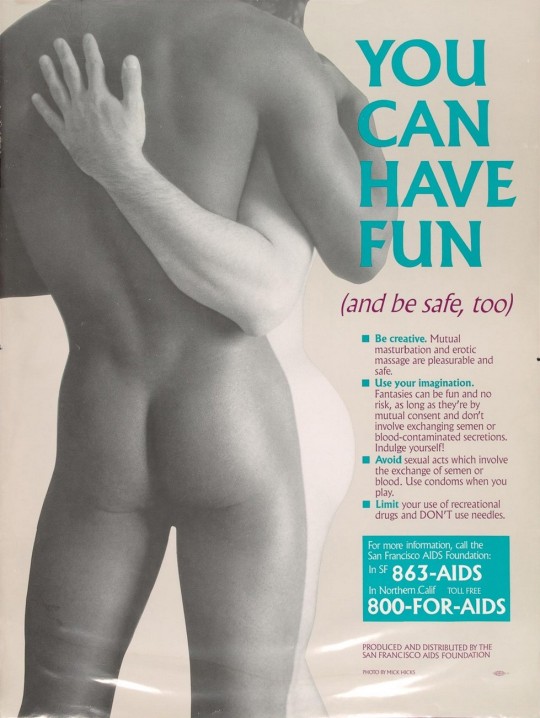
“You Can Have Fun Too” poster, created by Mick Hicks for SFAF, 1984
"In 1984, Rick Crane, director of the (San Francisco AIDS Foundation) at the time, hired famed local photographer Mick Hicks to photograph two men for a safe-sex poster to be put in the city’s gay bars, baths, and other locations. Hicks worked for virtually all the LGBTQ newspapers in the Bay Area and had spent a year and a half photographing people with AIDS, chronicling their struggle with the disease. He quickly accepted the commission.
At the same time, a young Black man named Robert Gray, a native San Franciscan raised in the Bayview Hunter’s Point area of the city, and a proud sixth-generation descendant of the Georgetown 272 (a group of 272 African slaves who were sold, in 1838 by the Jesuit priests who ran George University to keep the school afloat), was rather well known in the Castro and Tenderloin areas. “I had started meeting and dating guys in my junior year in high school,” he told me. “I went to high school four or five blocks from the Castro. I would find my way up through the bar scene during that time, sneaking into gay bars and discos.” Of course, he realized that AIDS was rampant through the city.
One day, as 24-year-old Robert wandered down Castro Street, a man approached him and asked if he would pose for a photo for a safe-sex poster for San Francisco AIDS Foundation. “The gentleman advised me that a young photographer named Mick Hicks was looking for two subjects, one Black male and one white male, for the poster. Having seen so many of my personal friends succumb to this deadly virus, I felt it was something I needed to do to help stop the spread of this horrific disease. I asked myself, ‘Why not?’ With AIDS affecting so many of my gay brothers and sisters, I felt it was my responsibility to do something to contribute to AIDS awareness and prevention. I needed to take action, whatever I could do to be a voice of action and help my community.” He agreed on the spot to do the poster.
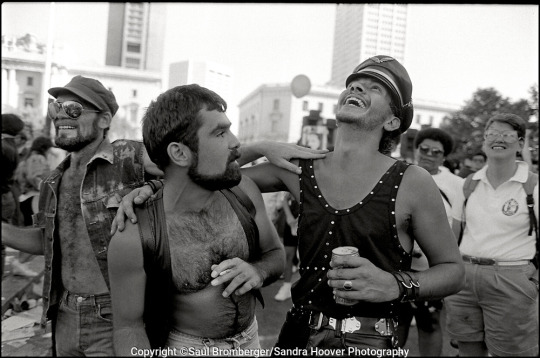
“You Can Have Fun (and be safe too)” read the final poster. The image that Hicks created featured Robert, shot from the back, embracing a white model (Hicks’ partner Nick Cuccia), his white arm and bubble-butt standing out prominently against Robert’s skin. Even the Chronicle columnist Herb Caen took notice of the photo. The sex-positive message of the poster advocated “mutual masturbation,” “erotic massage,” “imagination and fantasies,” and “limiting social drugs.” The poster portrayed and promoted gay sex as normal, expected behavior, and emphasized the pleasure that could be had while still protecting oneself against transmission of the virus. The poster caused a huge sensation and started appearing in gay bars, discos, and bathhouses from San Francisco to New York. Mr. Gray told me, “As the young kids would say today, ‘it went viral,’ no pun intended!”
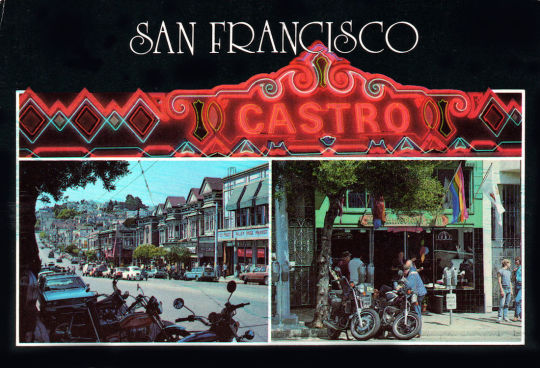
(Castro, San Francisco postcard, 1984)
Regrettably, the poster also launched a two-pronged backlash, one prong based in religious prudery, the other in racism.
By asserting that gay sex could be both fun and safe, the poster was the first to portray gay sex as normal, healthy, and fun. Even before AIDS, gay sex had been viewed as aberrant, “unnatural.” As an offshoot of that prejudice, AIDS was thought by many as a visitation of the wrath of God on immoral men who were violating God’s law. How many times did we hear in the early 1980s, “At least AIDS is killing all the right people”? The poster’s sex-positive message was condemned as an affront to decency and family values.
Even more lamentably, the poster inadvertently shone a light on the racial animus within San Francisco’s gay community. As Rick Crane told the Bay Area Reporter in 2014, “Gays as a group were considered second-class citizens and, ironically, gays themselves were treating gay blacks the same way — as second-class citizens.” Although racial tensions had eased somewhat from the flashpoints of the ‘60s and ‘70s, there was still a clear racial divide in the bars in the Castro. The Pendulum was the Castro’s only gay bar where black men and white men went comfortably to meet; the other Castro bars catered primarily to whites. The Trap, located in the Tenderloin district, also catered to interracial couples. Thus, some of the bars and other establishments refused to display the poster, deeming it “unacceptable.” Regarding the response to the poster, Gray said, “I would go into bars, and I would hear the chatter amongst people about the poster. I heard some really positive things, but also some really negative, racially motivated things.
(Below: "Thyrell And Chris Outside The Pendulum Bar SF", 1986 by Jim James aka Photojimsf)

“At the time that I did the poster,” he continued, “I had no idea that it would be so controversial. Honestly, had I known this upfront, I might not have done it. But looking back on it now, I would do it again because it was the right thing to do.” But still, he laments, “Who would have thought that a photo would open my eyes to the racism within the gay community? We are so much more alike as a people than different. One would think we could get along better and come together for a cause greater than us individually. Being a proud Black gay man, I must fight harder than most for myself and for those who come after me.”
These days, Robert Gray is still that proud Black gay man who changed the face of safe-sex advocacy. Sixty-two years old now, nearly forty years since he posed for the SFAF poster, he is semi-retired and lives in Vallejo, California. He is now a widower, having lost his partner of 42 years (his husband since 2013). He remains quite proud of the poster to this day, even if that pride is somewhat tempered by what he considers a lack of recognition for his work. “I thought over time I would see the poster in the gay pride parades or that I would be given some special honor from major players in the movement, like GLAAD. There is still a lot of racism in the gay community.”
Adapted from a February 18, 2022 article by Hank Trout:
https://www.sfaf.org/collections/status/why-did-a-safe-sex-poster-spark-controversy-in-1984/
38 notes
·
View notes
Text
I love the house md fandom. House and Wilson are both objectively terrible people. They are perfect for one another. The show is absolutely insane and half the shit that happens in it sounds like a joke. House loves his stories so much he has a radio TV for his soaps. There’s an openly labeled bisexual character. House agrees to murder her. This show came out in 2004 on Fox and House and Wilson have been having gay sex since episode one. Cameron helps Chase cover up a murderer and then divorces him anyway. House is a nephrologist. We call this show hatecrimes md. But not even in a way where we pretend to hate it. The show is wild and could not be described. It’s loved by the gay sex girlies. Unironic old man yaoi. The show ended in 2012, before gay marriage was federally legal, and Wilson proposes to House on screen. There’s the same brain virus in all of us and we are all aware of it.
#mine#house md#if you’re questioning Wilson being a bad person#uh#it’s more than I can explain in the tags#but he spends so much of his life knowingly enabling house#committing crimes with and for him#this is independent of Wilson having something wrong with him that the Dsm can’t describe
48 notes
·
View notes
Note
gonna share an evil virus with you (the virus is gay sex) (its done via usb port)
oh noooo not an evil virus *ensures my usb port is open and ready to receive your bus* (by spreading my legs)
70 notes
·
View notes
Text
btw whenever theres a big callout (aka evry day tgese days) i remember this guy i used 2 know irl in highschool who was a zoofile i shld tell u guys abt him he was an interestinv person forsure, we met at tge junior earth science national olympiad in 8th grade & he didnt want 2 tell us his name bc he said he doesnt like it szo we called him r2d2 tge whole time & only found out his name when he was called on stage 2 receive some award for how well he did in chemistry (earth science olympiad btw had 4 papers iirc physics chemistry biology geography & he said he finished da chemistry paper & then left 2h early and left tge papers for da other subjects blank since he "was only there for chemistry anyway"). as u can tell tge autism was strong w this r2d2 guy, & when we were alone in a room 2gether coming out 2 each other he told me he was "gay, or technically speaking u can say bisexual: i like men and dogs". i didnt understand what he found attractive in dogs szo i asked him 2 explain (at tge time i thot i cld innately understand any sexuality bc i identified as a lesbian but cld easily get off 2 gay porn). anyway bro that night for 6 hours or szo he kept explaining tge anatomy of dog dicks to me, w imagea of yiff he had saved on his phone as visual guides. for context btw taht was tge night after the actual exam of da olympiad was over but b4 tge results had been announced, all tge kids from all over the country who had qualified for the national phase of tge contest were housed 2gether in tgis 1 hotel & taht night obviously every1 was partying i think me & him were the only sober ppl there, at 1 point my roommate walked in 2 tell us da results had been posted & he was like let me finish my train of thought & he kept talking abt knots for at least 5 more minutes b4 we cld go look at da results. anyway from then we became online friends, usually he showed me chemistry problems & told me abt tge world he had invented where lychantropy was real, he admitted hed come up w tgis world szo he cld think of 'realistic' werewolf sex but he was mostly just talking abt how hed chaged da rules of chemistry in taht world szo da werewolf virus cld exist. 1 day he went "bro bro i realized y i shldnt fuck a dog, its bc da dog wldnt realize wtf i was doing since we cant communicate so it wld just b rape" & i told him - forgive me, i was more ableist bavk then - i told him yk if it took u tgis long 2 figure it out mayber ur intelligence level b4 was low enough taht it rlly wldve been ethical for u 2 fuck a dog. we werent friends for long tgo we never fought or anything but i think he realized i just cldnt understand enough chemistry 2 get what he was saying most of da time szo we started talking less & less etc yk how it goes. idk i hope he moved 2 sweden like he wanted & ik ive been using male pronouns for him but i rlly wish he transitioned ik all my beautiful female followers r attracted 2 him by now szo as a trans lesbian he cld easily find some1, tgis part is pretty vain but i hope he goes by r2d2 full time now, he was pretty chubby 2 szo estrogen cld give him rlly big tits fr... anyway da point of tgis post was, if any of those callout aidens actually had 2 b lgbt in a conservative place like eastern europe tgey wldnt even think abt ostricizing some1 for some fetish even if da guy looked tgem in tge eyes irl & explained exactly y he likes german shepherds💯
22 notes
·
View notes